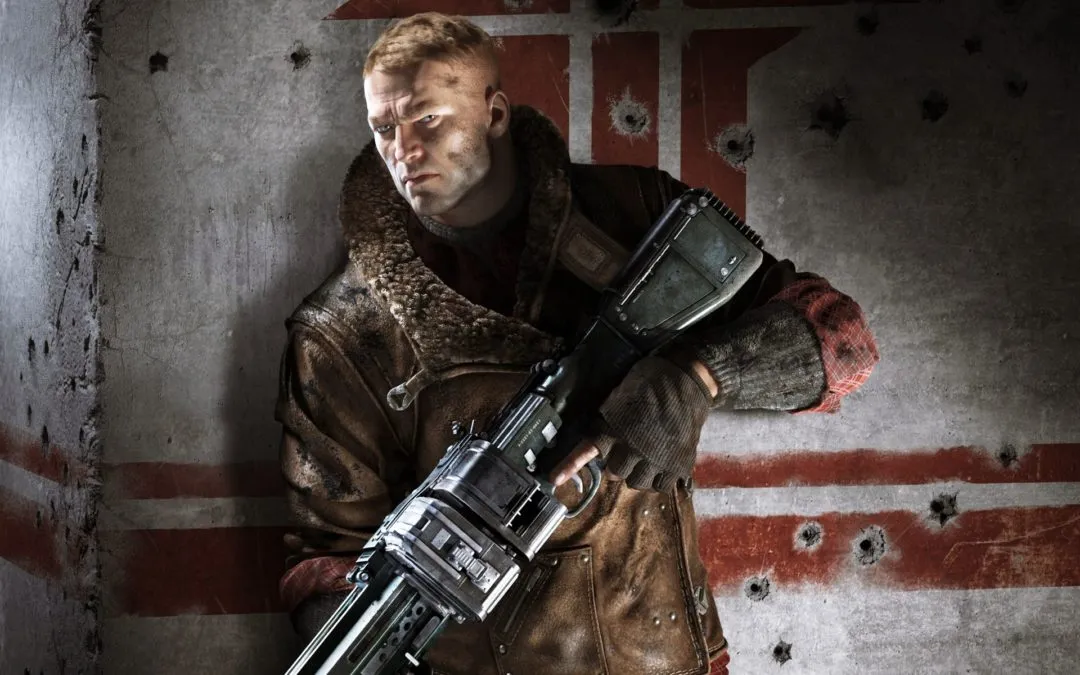It had taken two hundred years to dispose of the American aborigines, and Germany had almost done it in Africa in fifteen years. So no criticism was legitimately in order. – The Man in the High Castle
My generation was not raised to take Nazis seriously. They were chumps, easy to slot into any story for the lurid fun of mulching them without any qualms. Indiana Jones and the Blues Brothers hated those guys. Fighting them was a punchline.
That was also true in Wolfenstein 3D. It was not the first first-person shooter, but it was the one that kicked off the trend that would give us Doom and all that came after: a gunner’s-eye view of the action, focused on navigating labyrinthine corridors, collecting heavy firepower, and using it to inflict gory violence on an endless procession of foes. It was sensationalist and transgressive, calculated to incite pearl-clutching, and utterly unserious. Beating the game meant pumping enough Chain Gun rounds into a robotic Adolf Hitler to destroy him.
These portrayals defined “Nazi” for me for the first years of my life, punctuated only by the odd time classmates called me a “grammar Nazi” or that unbearable Soup Nazi Seinfeld episode. Then I got old enough to read The Diary of Anne Frank and Elie Wiesel’s Night and to see documentaries about World War II. To be old enough to understand the full enormity of the thing is to gain a sobering understanding of what our responsibility is toward historical literacy, civic engagement, and empathy toward our fellow people. As a sizeable portion of the country cheers for non-white politicians to get “sent home” while an openly racist and xenophobic president’s administration jails foreign refugees without trial, the chuckling silliness of stuff like Wolfenstein 3D or Kung Fury, where an ‘80s Miami detective time travels to Nazi Germany, seems somehow unintentionally complicit.
And yet my hopes for Wolfenstein: Youngblood, which releases on July 26, couldn’t be higher. When the series came back from a five-year hiatus to deliver Wolfenstein: The New Order in 2014, it did what I had thought was impossible: It actually made Nazis scary again.

“The old and the weak are doomed.” – B.J. Blazkowicz
The Wolfenstein series launched on home computers in 1981 with Muse Software’s Castle Wolfenstein, an earnest action puzzle game with some roguelike elements. Players controlled a prisoner of war locked in the eponymous Nazi castle and had to pilfer sensitive documents and escape through a combination of fighting and sneaking. Castle Wolfenstein is thought to be the first PC game with speech, which takes the form of German phrases Nazi soldiers bark at players as they navigate the castle. The 1984 sequel, Beyond Castle Wolfenstein, went bigger, tasking players with assassinating Hitler with a bomb in a gambit that recalls the real historical attempt on Hitler’s life that was depicted in the movie Valkyrie.
The games were hot enough that id Software negotiated for the rights to use the name when it trotted out Wolfenstein 3D in 1992, marking a change in tone and scope akin to the jump between Duke Nukem II and Duke Nukem 3D. It seems inevitable that some of the historical urgency would get lost as a result of the rock star game development attitude of the ’90s. Fascism as a global power had been gone for decades, and more and more of the men and women who lived through and fought in World War II were passing away. We had beaten Nazis, and didn’t want to look too closely at why we had to. It was better to just let Nazis be stand ins for atrocities and oppression and use them as disposable cannon fodder for the slew of World War II-era shooters released in the early 2000s.
Return to Castle Wolfenstein from 2001 and Wolfenstein 2009 followed the trends of the day rather than setting new ones. The former was a gray/brown military shooter, and the latter seemed to snatch stylistic choices from every other contemporary shooter imaginable. It was so unremarkable that the Escapist’s own Yahtzee felt he had to write his review in limerick form just to keep things interesting. Neither game made any room to acknowledge the real depth of the evil of the Third Reich. Nazis were bad guys who wanted occult and super-science powers, but it was too painful to think about what they wanted to use them for.

The franchise returned in 2014 with Sweden-based developer MachineGames, a team who had a much more visceral reaction to Nazism in the wake of that country’s wave of neo-Nazi marches in the ’80s. Wolfenstein: The New Order brings the immediacy of the Nazi threat to the foreground of the game’s narrative. These are Nazis whose cruelty is rooted in an ironclad presumption of racial superiority, and who explicitly seek world domination and the extermination of entire peoples.
The 2017 sequel Wolfenstein II: The New Colossus brought the narrative to our own shores, imagining what America would be like after more than a decade of Nazi occupation. The protagonist, B.J. Blazkowicz, grew up in the South with a white father and a Jewish mother at a time when Jewish did not ever mean white. The New Colossus’s story lays bare the ways in which Nazism and America’s particular strain of white nationalism echo one another through the bigotry Blazkowicz must grapple with. News articles, recordings, and incidental dialogue paint a picture of an America where the most appalling racial discrimination is living right out in the open and most people remain unperturbed. They’re aware of it, on some level, but they won’t be moved to resist it because they’re kept just comfortable enough.
The Nazis of these new Wolfenstein games, with their bone-deep cruelty and racist sadism, are in every way modeled on the Nazis of history. They nuke and gas cities, speechify about the Master Race, crank out propaganda that by all indications seems to be working. They coddle a senile, infantile Hitler and fulfill his every violent whim. They herd people into camps.
In a turn that’s all the more awful for how true it feels, we discover that they’ve done to B.J. what relentless racist nationalism has done to so many of us: It’s taken the worst impulses of his father and taught the man that his violence and bigotry are right, built a whole society around reinforcing it. If only B.J. realized that if you play by their rules you can do well, his own father rants at him, totally secure in the belief that his inhumanity toward his own family is justified. If only B.J. could overlook the fact his own mother was taken. If only he could see that around these parts their family name is respected again…
All of this would simply be depressing, if it weren’t followed up by the opportunity for you to just rip apart Nazis for days. The reason it feels so cathartic is because for the first time, the Nazis don’t feel like random digital clay pigeons. They feel like the villains they are.





Published: Jul 25, 2019 12:30 pm